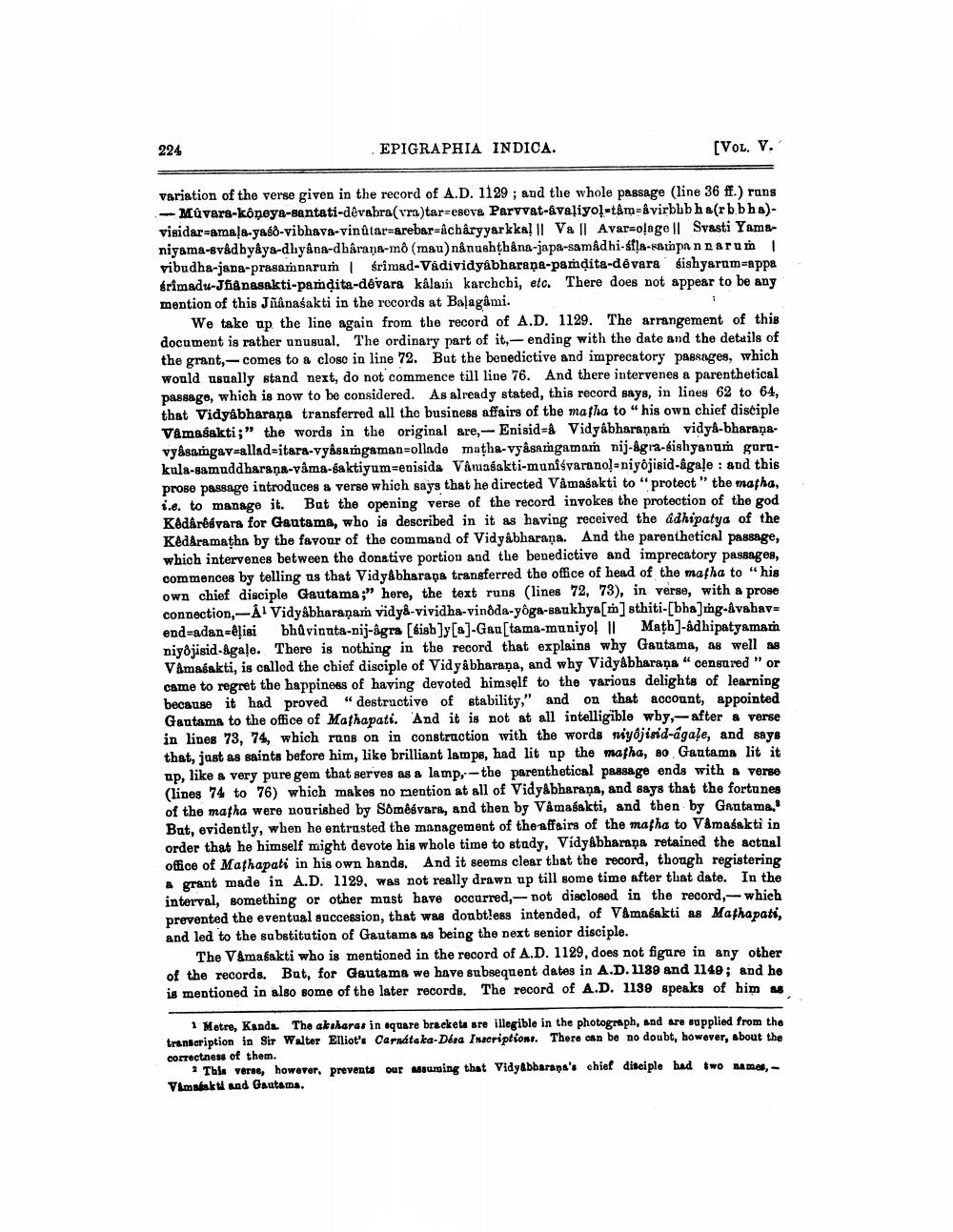________________
224
EPIGRAPHIA INDICA.
(VOL. V.
variation of the verse given in the record of A.D. 1129; and the whole passage (line 36 ff.) rans -Mûvara-konoya-santati-dévabra(vra)tar-eleva Parvvat-avaliyol-t&m=åvirbhbh arb.bha)visidar-amaļa-yaśð-vibhava-vinūtar=arebar-acharyyarkka! || Va || Avar=olage || Svasti Yamsniyama-svådhyâya-dhyana-dharana-mô (mau) nânushthana-japa-samadhi-stļa-sapannarum vibudha-jana-prasamnarum Srimad-Vadividyabharana-pandita-devara' sishyarum=appa srimadu-Jfignasakti-pamdita-devara kalau karchchi, etc. There does not appear to be any mention of this Jñanaśakti in the records at Balagåmi.
We take up the line again from the record of A.D. 1129. The arrangement of this document is rather unusual. The ordinary part of it-- ending with the date and the details of the grant,-comes to a close in line 72. But the benedictive and imprecatory passages, which would usually stand next, do not commence till line 76. And there intervenes a parenthetical passage, which is now to be considered. As already stated, this record says, in lines 62 to 64, that Vidyabharaṇa transferred all the business affairs of the matha to his own chief disciple Vámasakti;" the words in the original are,- Enisid=& Vidyabharanam vidya-bharanavy&samgav=alladaitara-vyasamgaman-ollade matha-vyåsamgamam nij-agia-sishyanum gurukula-samuddharana-vâma-saktiyum=enisida Vâmasakti-muniśvaranol-niyojisid-agale : and this prose passage introduces a verse which says that he directed Våmasakti to "protect " the natha, i.e. to manage it. Bat the opening verse of the record invokes the protection of the god Kedårésvara for Gautama, who is described in it as having received the adhipatya of the Kedaramatha by the favour of the command of Vidyabharaṇa. And the parenthetical passage, which intervenes between the donative portion and the benedictive and imprecatory passages, commences by telling us that Vidyabharana transferred the office of head of the matha to “his own chief disciple Gautama;" here, the text runs (lines 72, 73), in verse, with a prose connection.--A Vidyabharaṇam vidya-vividha-vinôda-yoga-saukhya[m] sthiti-[bha]ing-åvahav= end=adan=eļisi bhūvionta-nij-igra (Gisb]y[s]-Gaustama-maniyo! | Math]-adhipatyamam niyðjisid-&gale. There is nothing in the record that explains why Gantama, as well as Vámasakti, is called the chief disciple of Vidyabharaṇa, and why Vidyabharana“ censured" or came to regret the happiness of having devoted himself to the various delights of learning because it had proved "destructive of stability," and on that account, appointed Gautama to the office of Mathapati. And it is not at all intelligible wby,- after & verse in lines 73, 74, which runs on in construction with the words niyojisid-agale, and says that, just as saints before him, like brilliant lampe, had lit up the matha, 80 Gautama lit it ap, like a very pure gem that serves as a lamp, the parenthetical passage ends with a verse (lines 74 to 76) which makes no mention at all of Vidyabharana, and says that the fortunes of the matha were nourished by Sômêsvara, and then by Våmasakti, and then by Gautama, Bat, evidently, when he entrusted the management of the affairs of the matha to Våmasakti in order that he himself might devote his whole time to study, Vidyabharaṇa retained the actual office of Mathapati in his own hands. And it seems clear that the record, though registering a grant made in A.D. 1129, was not really drawn up till some time after that date. In the interval, something or other must have occurred, - not disclosed in the record, which prevented the eventual succession, that was doubt!ess intended, of Vámasakti as Mathapati, and led to the substitution of Gautama as being the next senior disciple.
The V&masakti who is mentioned in the record of A.D. 1129, does not figure in any other of the records. But, for Gautama we have subsequent dates in A.D. 1189 and 1149; and he is mentioned in also some of the later records. The record of A.D. 1139 speaks of him as
1 Metre, Kands. The akaharas in square brackets are illegible in the photograph, and are supplied from the transcription in Sir Walter Elliot's Carnataka-Désa Inscriptions. There can be no doubt, however, about the Correctness of them.
1 Tble verse, however, prevents our Muming that Vidyabharana's chief disciple had two name, - Vimatakti and Gautama.




